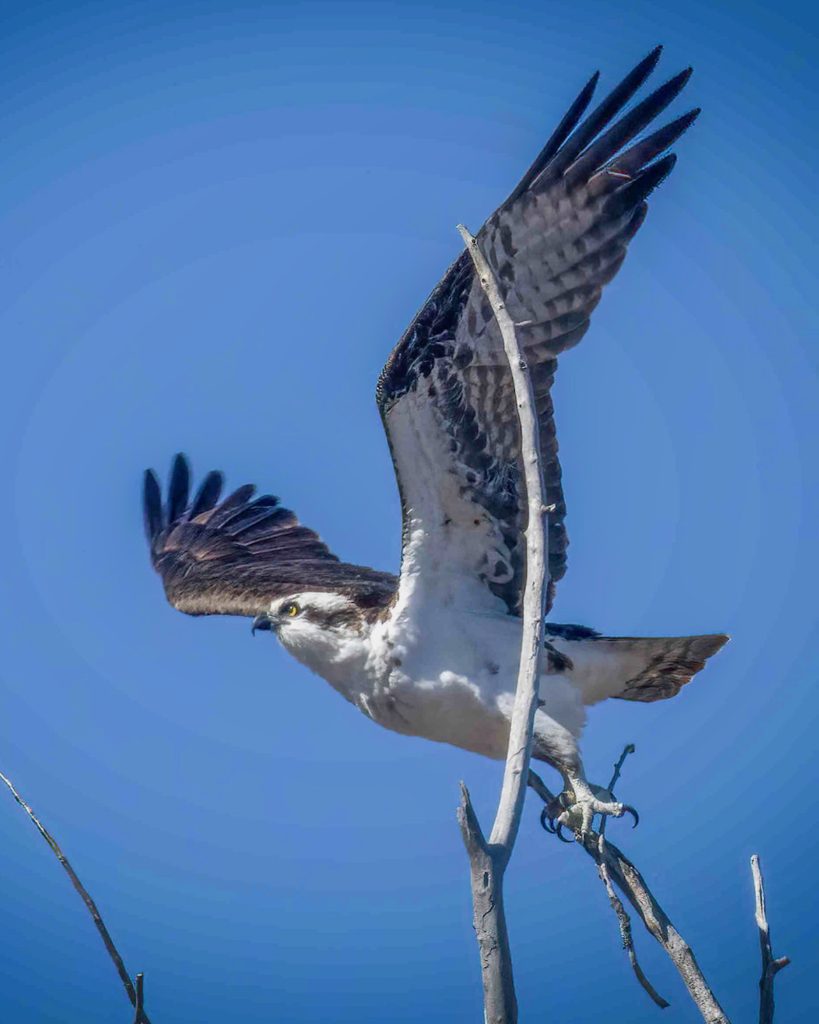Eagle County’s ospreys are majestic birds of prey who stick together

Rick Spitzer/Courtesy photo
The most common raptor in Eagle County is most likely the osprey. As you drive through the county, you will see their nests on the top of many trees, poles, power poles, and athletic field lights.
Beginning in September or October, ospreys begin wintering in the southern states, but they migrate back to Eagle County in late March and early April to nest at the same sites they used in the past.
With a 70-inch wingspan, they are large birds. They are found on all continents except Antarctica. In South America, they are considered non-breeding migrants. Only the peregrine falcon is more widely distributed worldwide.

Where to spot nests
Ospreys are known as sea hawk, river hawk, and fish hawk. As those common names suggest, the osprey’s diet consists almost exclusively of fish. A word to add to your vocabulary: a piscivore is a carnivorous animal that primarily eats fish. Because of that diet, ospreys will nest in any location near a body of water that will provide an adequate food supply.
Look for their nests around the valley — they are easy to spot. Many are on top of power poles, but those can be dangerous for the bird and sometimes cause power outages for people nearby. Many birds have been electrocuted by the power lines that are near their nests.

Support Local Journalism
Power companies have modified the area around many of those poles to reduce the possibility of electrocution or prohibit nesting altogether. In addition, many local agencies and conservation groups have gotten involved and erected poles with a flat base on top for the birds to nest. You may also find their nests on the top of light poles in many sports fields in the area. The bright lights and noise do not seem to bother the birds.

A few years ago, one pair of birds built a nest on top of a lift tower on the Westin gondola at Beaver Creek. Workers discovered the pair of nesting ospreys, which put a halt to the regular offseason maintenance. Osprey, active nests, eggs, and young are protected under the Federal Migratory Bird Treaty Act. Inactive nests that have no eggs or flightless young can be removed without a permit. After the birds left, a fake owl was put on the tower. When the birds returned, they frequently attacked the fake owl. They ended up nesting nearby.
Ospreys pair for life. When the birds arrive to their nest each year, they repair and add to it. In addition to poles, osprey will build nests at the top of trees and in some areas on the ground. When an osprey gathers sticks for the nest, it may break dead twigs off the top of nearby trees. Other material may be included, and people have observed osprey nests that contained hula hoops, rag dolls, toys, bailing twine, and fishing line.

One to four eggs are laid, and they usually hatch between 35 to 43 days. They will fledge in 50-60 days after hatching. The adults spend a great deal of time fishing to feed their young, an activity that is amazing to watch.
Bald eagles capture fish by flying low over the water and grabbing a fish swimming near the surface. Ospreys use a different technique. Ospreys have a vision that is well adapted to detecting fish below the surface. They circle and hover, and when they locate the fish, they swoop down at an angle and go into the water feet first to grab the prey. They adjust the angle of dive because, due to refraction of the water, the fish’s image is not where the fish is.
The bird may get completely submerged. After a few seconds, they begin to flap and fly out of the water with their prey in their talons.
One feature that makes the osprey unique is the fact that its outer toe is reversible. This allows the birds to hold a fish with two toes on each side of the fish. This is particularly useful with slippery fish. Once airborne, they will orient the fish so that the head of the fish is pointed in the direction of travel to reduce air resistance as they fly to a tree or back to the nest.

Mythical origins
The osprey’s scientific name, Pandion haliaetus, comes from a mythical king of Athens, Pandion, whose daughters were turned into birds, and the Greek words halos (sea) and aetos (eagle). The characteristics of osprey are so unique that they are classified in their own taxonomic genus, Pandion.
Life for an osprey can be tough. The weather in Colorado varies, and spring snowstorms can take a toll. Collisions with power lines, cell towers, other human utilities, and collisions with aircraft cause some mortality.
In the 50s and 60s, the population of ospreys decreased due to insecticides such as DDT. Ospreys are occasionally poisoned by lead fishing weights. Fish ingest the weights and ospreys ingest the lead. Water Pollution and rubbish in the water are also problems. Ospreys can get entangled when they dive for fish or grab objects floating in the water, including trash, nets, and fishing line. Insecticides, rodenticides, and fertilizer gets washed into rivers, lakes and ponds. This can kill the fish directly or produce algal blooms that can kill fish. This, in turn, can have an impact on the survival of the osprey.

Recreation and human development may impact the population, though ospreys seem to be more tolerant than other raptors. If you see a nest, Colorado Parks and Wildlife says that there should be no human encroachment activities within a quarter-mile (1320 feet, 400 meters) radius of active nests during nesting from April 1 through July 31. Some osprey populations have habituated and are tolerant to human activity near their nests.
Many of the nests in Colorado are near roadways, walkways, and bike paths within that restriction. The best strategy for observing and photographing osprey is to park in a safe spot along the roadway and shoot from inside your car. Birds on roadways usually do not respond to this activity. Getting out of your car may cause them to react negatively.
If you get the opportunity to watch an osprey dive into the water of a local river or pond, you may find it hard to believe what you are watching.
Rick Spitzer is a renowned wildlife photographer and longtime local who lives in Wildridge. The Eagle County Community Wildlife Roundtable is a collaborative partnership with the White River National Forest, Colorado Parks and Wildlife, Bureau of Land Management, local government entities, community members, and citizen scientists. The purpose of the Eagle County Community Wildlife Roundtable is to gather a group of diverse stakeholders in the valley to understand and address issues facing wildlife populations.











